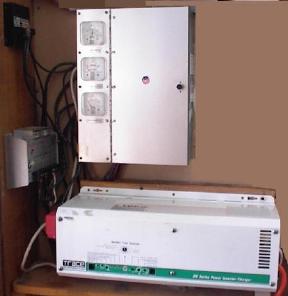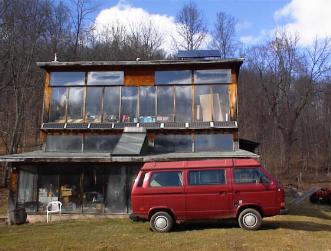Drew Tanner
Staff Writer
The power lines don't go out to the Condons' home in Lobelia, but step inside their home and you'll find the usual creature comforts: a fridge, washing machine, television, lights, a computer. In fact, Mike is a webmaster for several local businesses.
Since the mid-1980s, Mike and Danette Condon have powered their home completely independent of the nation's electric power grid with a collection of solar panels, a bank of batteries and a generator.
In their remote neck of the woods, the power company told the Condons it would cost around $5,000 to bring an electrical service line to their home. Instead, they initially spent about $4,000 adapting their home for solar heating and electricity.
Over time, they've learned what works-and what doesn't-and have refined their system accordingly.
Starting out, the couple said they didn't have much, but they simply added on and grew their system as money allowed.
"We were minimum wagers who were supporting an emerging industry," noted Mike.
"That's what we all did," Danette said of many of the families that moved to the area in the mid 1970s as part of the Back to the Land movement. "We put our money were our mouth was. We did without some things, but we had energy independence."

18 Deep cycle 6 volt batteries comprise the electric storage capabilities. Wired in series as pairs to make 12 volts and then in parallel, maintaining 12 volts but increasing the amp/hours
Photo by Michael Condon
|
Today, their home's 12 solar panels power lights and appliances and charge a bank of deep-cycle marine batteries that provide power at night or during cloudy stretches. The house also harnesses solar energy for heat: sliding glass door replacements make up the windowed south side of the home's first and second floors. Rather than depend on an electric pump, water is supplied by a spring 19 feet above the home's grade. A solar water heater provides hot water for showers and washing duties.
A woodstove provides the balance of the home's heat and can also provide hot water when the sun isn't shining enough for the roof-mounted water heater.
For heavier chores, like running the washing machine or using power tools-which would place a heavy draw on their home's batteries, the Condons employ a modest propane generator.
It's a sophisticated set up that has surprisingly simple roots.
In 1983, with no electricity at their house, Mike discovered he could power a portable stereo with the solar fence charger they bought from Sears.

The white inverter is 22" wide 8" high, and draws little current when on standby.
The silver box with dials is the load center which contains automotive type fuses to protect the curcuits. The small black unit up high is the charge controler for the 4 roof panels. The small silver box is the charge controler for the 8 photovoltaic panels that run across the front of the building, this unit also has an automatic low voltage disconnect(to protect the batteries from over discharge which can shorten their life).
Photo by Michael Condon
|
The idea for other solar applications around the house grew from there.
Their original system ran on 12 volts, which required converting lamps and buying appliances that can run on such a system.
Since then, the Condons added an inverter that converts the 12 volts generated by the solar panels, also called photovoltaic cells, to the 120 volts common in 'on-the-grid' households. The inverted power is used by their computer, television and coffee grinder, while lights and music continue to run on the 12-volt system.
A 12-volt refrigerator was eventually replaced with a propane model, stretching the home's battery capacity even further.
Mike notes that the modular nature of solar power has made it easy to expand the system in phases, rather than financing everything with substantial debt.
"We appreciated what we got, when we got it, because we worked for it," he said.
For those who want to go solar or otherwise reduce their use of resources, Danette said each small step helps.
"If everybody takes whatever steps they can to conserve or do energy efficiency or do alternative energy, every step helps," she said. "And whatever you do, hopefully, makes you feel so good that you do something more."
"We started making changes in our own lifestyles in the 1970s to get where we are now," she added.
"This is one of the worst climates for solar, yet we've made it," she said.

All that glass helps us grow most of our greens thru the winter. But alas the washing of said windows awaits the return of our children. (they'll like that....)
|
|

Our concern for the planet goes beyond just power generation, so we go the extra mile to protect our state's waterways by managing our farmette organically. Often as we give thanks we notice that most if not all of the meal was Home Grown.
Photo by Michael Condon
|
Eight Rivers Web Designs Home Page
If you have any comments or questions write
omb00875@mail.wvnet.edu




